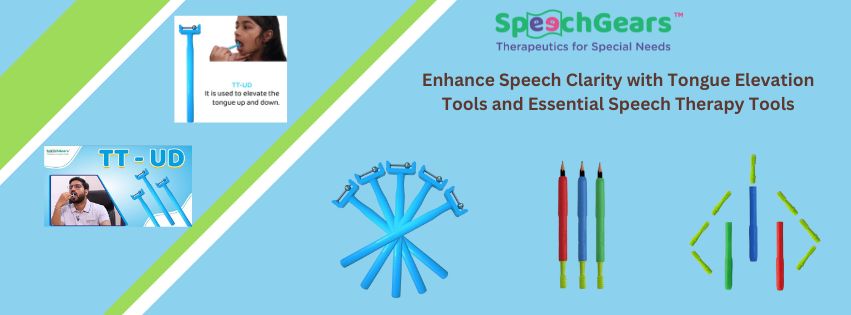Enhancing Speech Therapy: The Role of Tongue Elevation Tools and Other Essential Tools

Speech therapy plays a crucial role in helping individuals overcome various speech and language disorders. Among the numerous tools available to speech therapists and parents, the tongue elevation tool stands out for its effectiveness in improving speech clarity and articulation. This blog will explore the importance of the tongue elevation tool, its benefits, and other essential speech therapy tools that can be used at home or in clinical settings.
Understanding the Tongue Elevation Tool
The tongue elevation tool is designed to help individuals, particularly children, develop better control and strength of their tongue muscles. This tool is essential for improving speech clarity, as it targets the elevation and positioning of the tongue, which are critical for producing certain sounds correctly. The tool is simple to use and can be incorporated into daily speech therapy routines.
Benefits of Using a Tongue Elevation Tool
- Improves Articulation: Many speech sounds require precise tongue placement. The tongue elevation tool helps in practicing these placements, leading to clearer speech.
- Enhances Muscle Strength: Regular use of the tool strengthens tongue muscles, which is vital for articulation and overall oral motor skills.
- Boosts Confidence: As children see improvements in their speech, their confidence grows, encouraging them to communicate more effectively.
- Easy to Use: The tool is designed to be user-friendly, making it suitable for both therapists and parents to use with their children.
Other Essential Speech Therapy Tools
While the tongue elevation tool is highly effective, it is often used in conjunction with other speech therapy tools to provide comprehensive support. Here are some other essential tools that can enhance speech therapy sessions:
1. Flashcards and Picture Cards
Flashcards and picture cards are fundamental tools in speech therapy. They help in building vocabulary, improving pronunciation, and forming sentences. Using themed flashcards, such as animals, foods, or everyday objects, makes learning engaging and relatable for children.
2. Interactive Apps and Software
In the digital age, numerous interactive apps and software are available to make speech therapy fun and effective. Apps like “Speech Blubs” and “Articulation Station” offer games and activities that target specific speech sounds and language concepts, providing a dynamic and interactive learning experience.
3. Speech Therapy Worksheets
Worksheets are great for practicing specific speech and language skills. Activities like matching, fill-in-the-blanks, and drawing exercises target articulation, grammar, and vocabulary. These worksheets are often available online for free or can be purchased in comprehensive sets.
4. Storybooks and Reading Materials
Reading storybooks aloud is an excellent way to improve listening and speaking skills. Choose books that match the child’s age and language level. Engaging with the child by asking questions about the story and encouraging them to describe the pictures or predict what will happen next can significantly enhance their comprehension and verbal expression.
5. Visual Schedules and Charts
Visual schedules and charts help children understand and follow daily routines. They can also reinforce the sequence of sounds and words. Creating a visual schedule for speech practice time helps children anticipate and prepare for their therapy sessions at home.
6. Speech Therapy Kits
Investing in a comprehensive speech therapy kit provides a variety of tools in one package. These kits often include flashcards, games, worksheets, and other materials designed to address different areas of speech and language development. They offer a structured and systematic approach to home-based therapy.
7. Mirrors for Self-Monitoring
A mirror is a simple yet effective tool that allows children to observe their mouth movements while practicing sounds and words. This self-monitoring technique helps them understand how to produce sounds correctly and improves their articulation skills.
8. Sound Books and Talking Toys
Books with sound buttons and talking toys are highly engaging for young children. These tools provide auditory feedback and encourage repetition of words and phrases, which is crucial for speech development.
Conclusion
Speech therapy tools play a vital role in supporting the development of speech and language skills in children. The tongue elevation tool, in particular, is a powerful aid in improving articulation and muscle strength. When combined with other tools such as flashcards, interactive apps, and storybooks, it can provide a comprehensive and effective approach to speech therapy.
Parents and therapists can enhance the effectiveness of speech therapy sessions by incorporating these tools into their daily routines. Making the activities fun and interactive will keep children motivated and engaged, leading to better outcomes.
For a wide selection of high-quality speech therapy tools, including the tongue elevation tool, visit SpeechGears. By equipping yourself with the right tools, you can make a significant difference in your child’s speech and language development, paving the way for clearer communication and increased confidence.